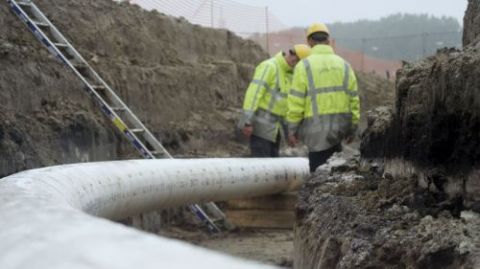Ammonia plant revamp to decarbonize: Yara Sluiskil
By Trevor Brown on February 01, 2019
Last year, Yara Sluiskil, in the Netherlands, upgraded its existing ammonia plant by introducing a hydrogen pipeline connection, thereby reducing its reliance on fossil fuels. The pipeline was commissioned in October 2018 and now “ensures the efficient and safe transport of hydrogen,” which was previously a waste-product at Dow’s nearby ethylene cracker. Already, the project “delivers a CO2 saving of 10,000 tons” and a decrease in energy consumption of “0.15 petajoules (PJ) per year.”
This is, perhaps, the first ammonia plant decarbonization revamp, and it shows that it is both possible and affordable to reduce emissions from existing ammonia plants today.
For decades, ammonia plant revamps have focused on increasing a site’s energy efficiency or, more precisely, reducing the plant’s specific energy consumption per ton of ammonia. This was always driven by economics, with the promise of reducing fuel and feedstock costs. But to meet the emission reductions mandated by the Paris Agreement, efficiency is no longer good enough: actual fuel and feedstock switching will be required. Future revamps may well therefore be driven by regulations more than economics (unless we count the threat of penalties levied against heavy-emitters).
I’ve written about the potential to convert existing ammonia plants to run low-carbon or carbon-free processes, especially with regards to revamp strategies for the addition of an electrolyzer alongside the steam methane reformation (SMR) unit, to feed hydrogen to the Haber-Bosch plant. I’ve also written about the decarbonization impact of using byproduct hydrogen (a 25% reduction in carbon footprint, relative to SMR), with regards to ammonia plants designed to consume a dedicated byproduct hydrogen stream.
Yara Sluiskil is different. This is a conventional ammonia plant, revamped to reduce carbon dioxide emissions incrementally. The site began operations in 1929 and now has three ammonia plants; it is Yara’s biggest production site, with an ammonia capacity of more than 1.5 million tons per year. The emission reductions are therefore minor at this stage: enough to support Yara’s corporate decarbonization goals, but not enough to enable the plant to begin selling any low-carbon products into the nascent green fertilizer market. However, the engineering and infrastructure that are in place now will reduce the cost of deeper decarbonization later. Ultimately, they could allow for the full integration of hydrogen produced from electrolyzers, eliminating the ammonia plant’s natural gas consumption.
The 12-kilometer-long hydrogen pipeline, on which agreements were signed in March 2018 between Dow, Yara, ICL-IP and Gasunie Waterstof [Hydrogen] Services, has been put into operation. Last summer the connections at Dow and Yara were made and the gas transport pipeline was adjusted on a few points to make it suitable for transporting hydrogen. The pipeline was then filled with hydrogen. The pipeline is now used on a commercial basis for transporting more than four kilotons of hydrogen per year …
Gasunie CEO Han Fennema: “This hydrogen pipeline marks an important point in our history. It is the first time that an existing gas transport pipeline has been made suitable for transporting a gas other than natural gas.”
Gasunie hydrogen pipeline from Dow to Yara now in use, Smart Delta Resources, 11/27/2018

The project began in March 2016, when the companies signed a “Green Deal,” and it is the first project to come out of Smart Delta Resources.
Smart Delta Resources (SDR) is a regional membership group that aims “to reduce the use of energy and feedstock through industrial symbiosis, in collaboration with the industry … [and] form a good lobby towards the government.” In addition to Yara and Dow, other SDR partners include SABIC, ICL, Engie, Cargill, and LambWeston.
Another partner of the Green Deal, and the owner-operator of the new hydrogen pipeline, is natural gas grid operator Gasunie, which established a hydrogen subsidiary for this project, Gasunie Waterstof Services (GWS). It has ambitions for growth in the region, targeting a hydrogen pipeline network capacity of 15 GW by 2030.
The first pipeline route that GWS manages is the hydrogen pipeline from supplier DOW Benelux to customer Yara Sluiskil. The completion of the project took place in October 2018.
It concerns a hydrogen transport system with 1 injector and 1 customer. This system only involves the transport of hydrogen, in which Dow brings hydrogen to a higher pressure in the system than the customer Yara consumes. There are no further operations (eg no compression, mixing or reduction). Assets for the hydrogen system are designed, managed, inspected and maintained in terms of functionality for a lifetime up to at least the year 2065.
Gasunie Waterstof Services website (translated by Google), Het project, accessed January 2019
SDR announced in November 2018 that “the pipeline will be officially launched with a mini-symposium” in early 2019. No details of this launch event are yet available but, in the meantime, GWS released an animated video that describes The story of Gasunie Waterstof Services.
You can also read the full article at AmmoniaIndustry.com.